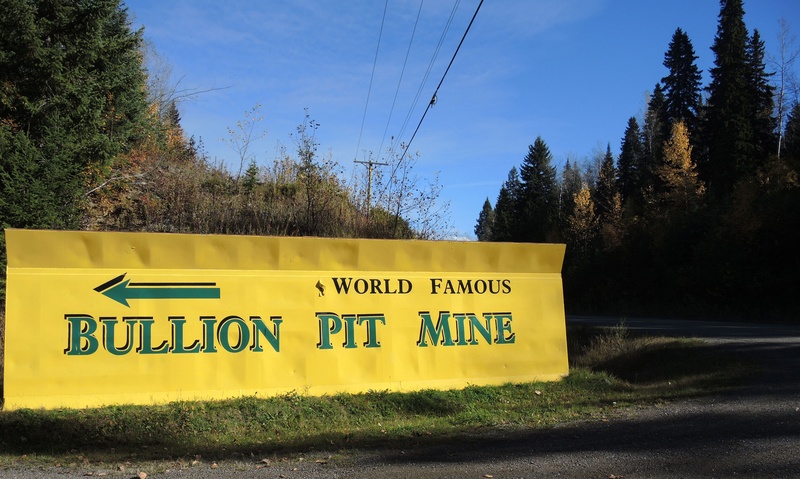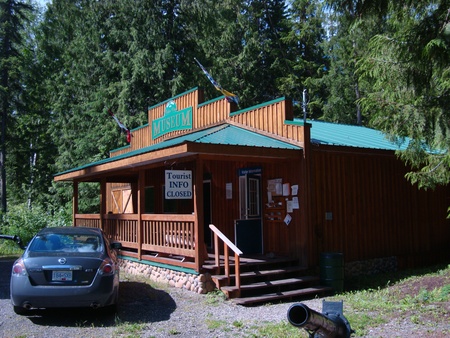When I was a young boy growing up in Hiroshima, Japan, my mother told me that my grandfather was living in Canada. From then on, I cherished a dream that one day I would go to Canada to meet him. However, in January 1955, when I was 10 years old, my mother received a letter from Vancouver telling her that he had passed away. My dream would not come true.
Fifty years have elapsed since that day. In 2005, I visited Canada for the first time and learned that my grandfather, Kanekichi Nakanishi, left Japan for Canada in one of the first groups of Hiroshima immigrants to work as coal miners in Cumberland on Vancouver Island, but that he left the mine and moved to Vancouver. Ms. Reiko Tagami, a research assistant at the Nikkei National Museum, showed me the book Hiroshima Immigrants in Canada 1891–1941 by Dr. Michiko Midge Ayukawa in which my grandfather’s name was quoted several times. In another book, Stories of My People, one description that drew my attention was Roy Ito’s reference:
Tadashi Nagao …[sold] cigarettes and newspapers in Hotel Vancouver. A Cariboo mine owner staying at the hotel asked Nagao if he could hire Japanese workers for him. Nagao with Kanekichi Nakanishi recruited ten men. Nagao found the work too hard and returned to Vancouver. Nakanishi prospered as the ‘boss’ of the mine workers.
About 30 years ago, my cousin told me that he met a Japanese mining engineer who had once worked in Canada. This person told my cousin that he heard about Kanekichi Nakanishi who worked in a Cariboo gold mine and that he was known as “kanayama no oosan.” I thought “king of gold mine” must mean a boss of gold mine workers. I became determined to know more about my grandfather’s life in Canada and to find the location of the gold mine where he worked.

I started reading books on the history of Japanese Canadians. In Kanada doho hatten taikan (Encyclopedia of Japanese in Canada by Nakayama Jinshiro, 1921), I found the names of some Japanese who worked in the Cariboo, but the article simply said: “Mr. Nakanishi worked in the Cariboo mine for three years; Mr. Tagawa worked in the Cariboo with his brother for three years; Mr. Kaminishi worked in the Cariboo mine for three years.” Neither the name of the mine nor its location was mentioned. I visited bookstores in Vancouver and bought books on the history of the Cariboo gold mines. Most of the books carried information on Chinese miners, but I could not find any information about Japanese miners. I studied a map and learned that the Cariboo was one-fifth the size of the entire country of Japan, too big to find the location of the mine by chance.
In 2010, on my way to Kamloops to visit my friend Mr. Kaminishi, I stopped at East Lillooet and entered a gift shop where books on Cariboo gold mines were on display. While scanning the pages of one book, I found a picture with a caption “A Japanese miner at the Horsefly Hydraulic mine.” The title of the book was Gold and Grand Dreams, Cariboo East in the Early Years by Marie Elliot.
With that clue, “Horsefly Hydraulic mine,” I started searching the sites of gold mines on the Web and found an article titled “Horsefly: Its Early History 1859–1915, Mining in Horsefly 1887–1902.” The article stated that “Mr. Hobson took over the Horsefly Hydraulic Mining Co. with 30 whites and 30 Japanese.”
I decided to visit Horsefly, a small mining town in northern British Columbia. The first gold in the Cariboo was discovered in the Horsefly River in 1859. In 2012, I visited the Horsefly Museum. A woman at the museum told me that there were some historic sites where Chinese people used to work, such as the “Chinese oven,” a remnant of the living quarters of Chinese miners, but that she had no idea about Japanese miners. She suggested that I visit a museum in Likely, BC, another of the few remaining Cariboo gold rush settlements, named after John A. Likely of the Bullion Pit Mine.
Just before entering Likely, I found a sign with the words “World famous Bullion Pit Mine” at a lookout overlooking the old mining site, and another sign with a brief history of the mine. The sign said: “The mine was renamed the Consolidated Cariboo Hydraulic Mining Company” and that “it employed more than 150 men, most of them Japanese.” I thought this could be the mine where my grandfather had worked more than 120 years ago.
When I visited the Cedar City Museum in Likely, I found a display on the history of the mine and the town of Quesnel Forks, a ghost town located 13 kilometres northwest of Likely. During the gold rush in the 1860s, the town had a population of 3,000 people. After the gold rush was over, some Chinese people stayed until the 1950s. I looked for any information on Japanese miners, but had no luck.
In 2014, I returned to Likely and visited the ghost town of Quesnel Forks but found no information on Japanese miners who had worked there. I found no trace of my grandfather in Likely, but while there I had a strange feeling that this was where he had lived and worked so long ago.
Back in Japan, once again I researched the Cariboo Hydraulic Mining Company and found the name “Bullion City,” a community where the owner and miners lived. I also continued my research on Kanada iminshi shiryo and found the following article.
Pioneer of Coal Mines and Gold Mountains
Around 1894, he (Nakanishi Kanekichi) was employed by a gold mine in the Cariboo and went there with twenty-six Japanese workers. He worked hard and gradually gained the trust of the company. …about 167 to 200 Japanese workers were engaged in extracting gold ore by dynamiting from May to November of every year. In those days of poor transportation, in order to reach the Cariboo, people had to first take a train from Vancouver to Ashcroft and then travel by foot for about 160 miles. Kanekichi Nakanishi worked for the gold mine there for 12 years and became a pioneer among Japanese mining workers.
—Tairiku Nippo, October 1940
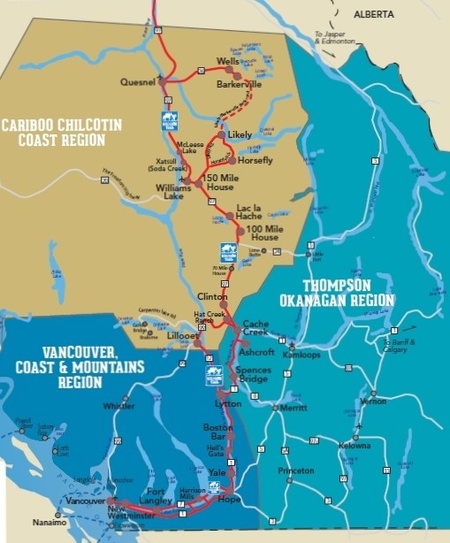
The distance from Ashcroft to Likely is about 283 kilometres, which meant that the Bullion Pit Mine could be where my grandfather worked. But the article was not sufficiently detailed to indicate that he actually worked there.
Looking for more evidence, I returned to Likely once again in 2015, this time with my wife, Yaeko, and inquired about Bullion City at the museum. The archivist explained that the site was now privately owned and that 15 years ago the owner who bought the site had demolished most of the buildings to build a public campground. After my wife and I returned home to Japan, I received an email from the owner saying that he had found old documents that were kept at the mine office. I asked him if he could search for any documents with names of Japanese miners. He sent me a picture of a document that read: “Travelling Expenses Amount expended by K. Nakanishi for expenses Japanese crew from Vanc’ to mine March 1897.”
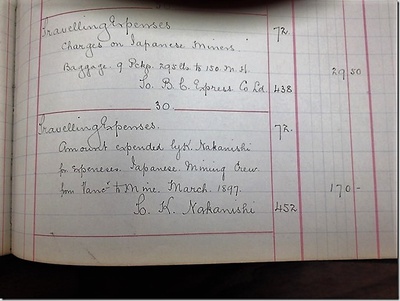
At last I had proof that my grandfather was employed at the Bullion Pit Mine 120 years ago. After 11 years of searching, my mission was finally complete. It is like a miracle that, after so many years, I found at last the gold mine where my grandfather lived and worked. I feel as if I finally met my grandfather in person in Canada.
A Brief History of the Bullion Pit Mine
“In the 1870s, Chinese miners first began mining gold on a small scale in the area that is now the Bullion Pit. Large scale operations began in 1894, when the China Pit property was purchased by J. B. Hobson, a mining engineer, on behalf of the Cariboo Hydraulic Mining Company.
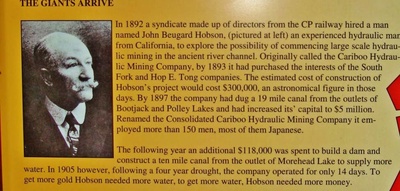 Road sign near Bullion Pit Mine describing John Hobson who was hired to develop Bullion Pit mining operations and very likely hired the Japanese workers as low cost labourers.
Road sign near Bullion Pit Mine describing John Hobson who was hired to develop Bullion Pit mining operations and very likely hired the Japanese workers as low cost labourers.By 1902, the company had built a camp known as Bullion City which consisted of about thirty-five buildings, including bunkhouses for 120 workers, a hospital, store, slaughterhouse, manager’s residence, stables, a blacksmith’s shop, a powder house, and other buildings.
The simple placer mining method of digging the gold-bearing material with shovels into a sluice box was replaced by hydraulic mining that employed jets of water under high pressure to wash away the overburden. Massive amounts of water were required. The supply of water was provided by damming local lakes and channeling the water through long ditches. An extensive ditching system was built in the 1890s, indicative of an enormous amount of hand labour.
By 1899, the company had built thirty-three miles of ditches, all dug by hand. Another labour intensive task was the building of sluice boxes which were seven feet wide and four feet deep. A total of 2,380 feet of sluice boxes were constructed. In the 1899 mining season, the company focused on the site that the original Chinese miners had worked in the 1870s, reworking the original tailings and using hydraulic methods on fresh ground. The Bullion Pit mine operated from 1892 to 1942.
Today, the Bullion Pit stands as an astonishing man-made canyon measuring 3 kilometres long by 400 feet (120 m) deep. It displaced 12,000,000 cubic yards of gravel.”
Reference:
Peter R. Mulvihill, William R. Morrison, and Sherry MacIntyre, “Water, Gold and Obscurity: British Columbia’s Bullion Pit,” The Northern Review #25/26 (Summer 2005): 197-210.
Images courtesy of Teruo Nakanishi.
*This article was originally published in Nikkei Images (Vol. 23, No.1).
© 2018 Teruo Nakanishi


